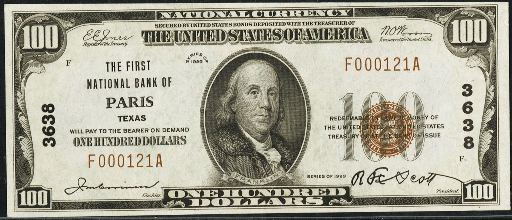The Omaha National Bank Of Omaha
The Omaha National Bank Of Omaha in Nebraska printed $10,586,980 dollars worth of national currency. Once a bank issues that much money there really isn’t much room for rare issues. However, there are certainly exceptions to every rule. This national bank opened in 1866 and stopped printing money in 1935, which equals a 70 year printing period. That is considering a long operation period for a national bank. During its life, The Omaha National Bank Of Omaha issued 20 different types and denominations of national currency. We have examples of the types listed below. Your bank note should look similar. Just the bank name will be different. For the record, The Omaha National Bank Of Omaha was located in Douglas County. It was assigned charter number 1633.
We buy all national currency. Please call or email us for a quote. Sales@AntiqueMoney.com
The Omaha National Bank Of Omaha in Nebraska issued 7,000 sheets of $5 original series territorial national bank notes. That printing range is high enough to allow for a couple of survivors, but not much more. You can do some quick math and take the sheet output, multiply it by four, and get the total number of original series $5 territorial bank notes issued by this bank. Only 30 banks in the country even printed these notes. Today there are only about ten surviving examples known to exist. Most of them are low grade and they are rarely available on the collector market. We are talking about bank notes printed before 1875, so the number of new discoveries being found 140 years later is minimal. Prices range from a few thousand dollars to tens of thousands of dollars based on any number of valuation factors.
Original Series $5 Territorial National Bank Note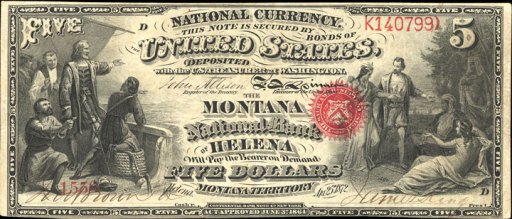
The Omaha National Bank Of Omaha printed 2,000 sheets of $1 original series national bank notes. A print range between 1,000 and 2,500 is small. Combine that with something that was printed before 1875 and you can imagine that these notes are few and far between. One of the most interesting things about early first charter one dollar national bank notes is all of the different slight variations you can find. Some notes have a red charter number, others do not. Some have red serial numbers and some have blue serial numbers. Some are printed on white paper and others are printed on paper with a slight blue tint. You can really find lots of different ways to collect these. Generally speaking, prices for “first charter aces” are down from their highs. So there are some bargains in this arena of collecting.
Original Series $1 National Bank Note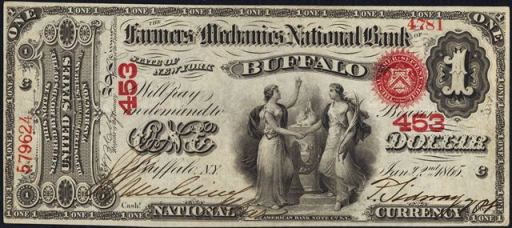
The Omaha National Bank Of Omaha also printed 2,000 sheets of $2 original series national bank notes. It is important to know production numbers for original series two dollar bills for informational purposes. All $2 bills printed before 1875 are very rare and highly desirable. Most survivors represent the only known example for that bank. Collectors call these $2 bills lazy deuces. The large two on the face of the bill is pictured horizontally, thus making it look lazy. Don’t be fooled by the silly name though. These can be worth significant amounts of money on many occasions.
Original Series $2 National Bank Note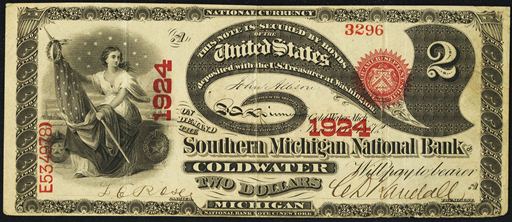
The Omaha National Bank Of Omaha also printed 7,750 sheets of $5 original series national bank notes. Just because a print range is between 5,000 and 10,000 doesn’t mean that individual notes will be easy to buy. That number isn’t really high or low. Some notes are extremely rare and some could be from a hoard. Values are determined based on condition and the number of known survivors. Each five dollar original series bank note has a spiked red seal. That is pretty much the only design difference between it and later issues. These are really beautiful notes. One neat thing about these is that the back of each note has a vignette of the corresponding state seal. Some of the state seals are very imaginative. Collecting by state seal was very popular early on in the hobby. Today most collectors are more concerned about bank of issue and condition. Serial number one bank notes are also extremely popular.
Original Series $5 National Bank Note
The Omaha National Bank Of Omaha also printed 2,250 sheets of $20 original series national bank notes. That issue number may or may not sound like a lot of sheets depending on your experience with collectible currency. However, all original series $20 bills are rare. The production amount is irrelevant when it comes to values. These seem like common issues until you want to buy one. These just aren’t readily available from rare banks in very fine or better condition. We definitely feel like these are undervalued in today’s market.
Original Series $20 National Bank Note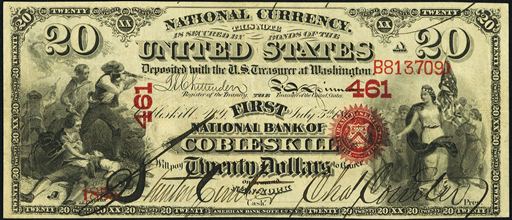
The Omaha National Bank Of Omaha also printed 171 sheets of $5 series of 1875 national bank notes. It is rare to see a sheet output of under 1,000 like this. However, it did happen for some very scarce issuers. Series of 1875 $5 bills are some of the most commonly encountered bank notes from the first charter series. Only the original series $1 bill is more available. Some banks exclusively issued five dollar bills. So if you want an example from one of those banks then you don’t have many options. These notes have a rounded red seal and red serial numbers. They also all have a red charter number.
Series of 1875 $5 National Bank Note
The Omaha National Bank Of Omaha also printed 732 sheets of $20 series of 1875 national bank notes. The exact number of series of 1875 $20 national bank notes printed by this bank is good to know. Don’t expect a high number to lower the value or a small number to increase the value. These notes are scarce enough on their own that the stats don’t really matter. Twenty dollars was a lot of money between 1875 and 1901, which is the time period in which these were printed. These just weren’t saved in high numbers.
Series of 1875 $20 National Bank Note
The Omaha National Bank Of Omaha also printed 10,585 sheets of $5 1882 brown back national bank notes. When we start talking about a printing number in the five figure range, then you are likely not dealing with a great rarity. However, the note could certainly still be popular and valuable. You can take the total number of sheets printed and multiply that number by four to get the exact number of 1882 $5 brown back bank notes this bank issued. Each note has a portrait of James Garfield on the left hand side of the bill. These are very popular with collectors because they have different text layouts. Some notes are worth as little as a few hundred dollars, but most are worth a good deal more.
Series of 1882 $5 Brown Back
The Omaha National Bank Of Omaha also printed 13,230 sheets of $10 1882 brown back national bank notes. When we start talking about a printing number in the five figure range, then you are likely not dealing with a great rarity. However, the note could certainly still be popular and valuable. There were three $10 bills printed on a single sheet of 1882 brown backs. The design of the bill is similar to all earlier ten dollar national bank notes. The nickname comes from the fact that these bills have a brown seal and brown overprint. Despite saying series of 1882, these were actually printed by some banks up until 1908. The date you see in cursive relates to when the bank first started issuing brown back notes.
Series of 1882 $10 Brown Back
The Omaha National Bank Of Omaha also printed 13,230 sheets of $20 1882 brown back national bank notes. Due to the way brown back sheets were printed we know that the sheet output number equals the number of $20 brown backs printed. When we see a number over 10,000 there is a good chance that the note isn’t going to be especially rare. However, it never hurts to ask. One neat thing about all brown backs is that they each have a different back design based on which state issued them. The back left hand side of the note shows the state seal of which ever state the national bank was located in. Generally speaking, 1882 $20 brown backs are pretty difficult to locate. They typically were printed in small numbers and they don’t have a great survival rate.
Series of 1882 $20 Brown Back
The Omaha National Bank Of Omaha also printed 4,509 sheets of $50 1882 brown back national bank notes. Not many banks printed $50 1882 brown backs. Sheet outputs aren’t extremely important. However, it is good factual information to know. The most common 1882 $50 brown backs are worth about $5,000. However, some can be worth more than $10,000 based on condition, serial number, and bank of issue.
Series of 1882 $50 Brown Back
The Omaha National Bank Of Omaha also printed 4,509 sheets of $100 1882 brown back national bank notes. Just because this bank printed more than 1,000 one hundred dollar brown backs does not mean that they are all common. We are very interested in purchasing $100 1882 brown back national bank notes. We have paid more than $15,000 for some examples. Send us pictures of what you have and we will respond quickly with an appraisal and offer.
Series of 1882 $100 Brown Back
The Omaha National Bank Of Omaha also printed 16,750 sheets of $5 1902 red seal national bank notes. Very few national banks printed more than 10,000 red seal sheets. Five dollar red seals are typically a little bit rarer than some higher denominations. That rarity is typically just a result of small issuances. Most national banks preferred to issue $10 and $20 1902 red seals. Each one of these five dollar bank notes has a portrait of Ben Harrison on the left hand side of the bill. Most people are quick to notice the cursive charter date with a year between 1902 and 1908 written on it. That date will never affect the value.
1902 $5 Red Seal National Bank Note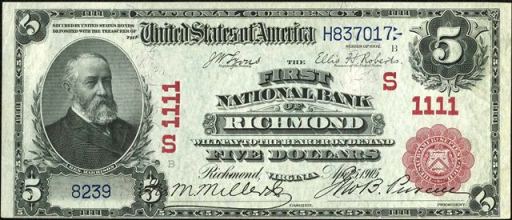
The Omaha National Bank Of Omaha also printed 3,033 sheets of $50 1902 red seal national bank notes. That is also the exact number of $50 red seals printed by this bank. Each sheet contained one $50 bill and one $100 bill. They are all extremely rare. The value for a generic circulated example is usually around $4,000. Most are worth more and some can be worth considerably more. John Sherman is pictured on each note. Otherwise it has the same markings you would expect to find on any 1902 red seal.
1902 $50 Red Seal National Bank Note
The Omaha National Bank Of Omaha also printed 3,033 sheets of $100 1902 red seal national bank notes. As we said above, all high denomination 1902 red seals are extremely rare. The number of notes printed really doesn’t matter to collectors. 1902 $100 red seals are rare to the point that they are always in demand. Of course the standard valuation rules still apply. Condition and bank of issue are of paramount importance. We have paid over $12,000 for some of the rarest specimens.
1902 $100 Red Seal National Bank Note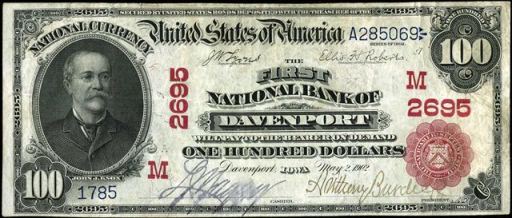
The Omaha National Bank Of Omaha also printed 53,330 sheets of $5 1902 blue seal national bank notes. Sadly, a printing range that high means that these blue seal bank notes from this bank are not going to be extremely rare. Ben Harrison is on the front of all 1902 $5 blue seal bank notes. This happens to be the smallest denomination issued for the 1902 series. Each note is complete with a blue seal and blue charter number. Despite saying series of 1902, these were actually issued by national banks between 1908 and 1928. There are two different types of blue seals. The first type is called a date back and it has “1902-1908” written on the back of the bill. The other type is called a plain back; it does not have the date stamps on the back of the bill. The values for these notes range widely based on condition and the bank of issue.
1902 $5 Blue Seal National Bank Note
The Omaha National Bank Of Omaha also printed 18,878 sheets of $50 1902 blue seal national bank notes. There is no trick to knowing which 1902 blue seals will be common and rare. Often times the number printed won’t tell you much information. The value still comes down to condition and demand. That is a surprise to most people. In fact, most 1902 $50 bills we see are worth between $750 and $1,250. The rarer ones can be worth more than $5,000. However, there isn’t much middle ground.
1902 $50 Blue Seal National Bank Note
The Omaha National Bank Of Omaha also printed 18,878 sheets of $100 1902 blue seal national bank notes. It is no coincidence that the sheet numbers for $50 bills and $100 bills are the same. They were printed on the same sheets. Most $100 blue seals are at least scarce; others can be very rare. John J Knox is printed on the front of each bill. Most collectors like the back design a lot more though. It is really unique and different from most other national bank notes. Prices for 1902 $100 blue seals are pretty similar to $50 blue seals. They are both equally common or equally rare, depending on how you look at it.
1902 $100 Blue Seal National Bank Note
The Omaha National Bank Of Omaha also printed 2,591 sheets of Type1 1929 $50 national bank notes. That is a pretty typical sheet output for a national bank during the small size era. As is the case with all modern fifty dollar bills, Ulysses Grant is pictured on the front of 1929 $50 bills. This is a higher denomination that was only printed by 300 different national banks. Many examples are only worth around a few hundred dollars. Rarer specimens can sell for more than $1,000.
Series of 1929 Type1 $50 National Bank Note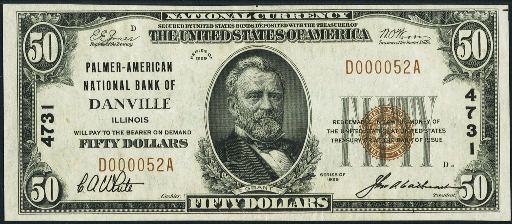
The Omaha National Bank Of Omaha also printed 873 sheets of Type1 1929 $100 national bank notes. This is a small print range, but it does not guarantee rarity. Despite saying series of 1929, all type1 national bank notes were actually printed between 1929 and 1933. Exactly 289 national banks printed $100 type1 notes. Most are relatively common. However, as with anything, there are always exceptions to that rule.
Series of 1929 Type1 $100 National Bank Note